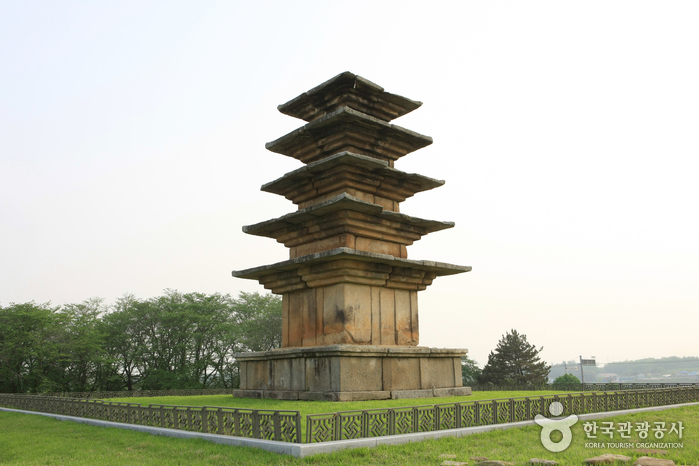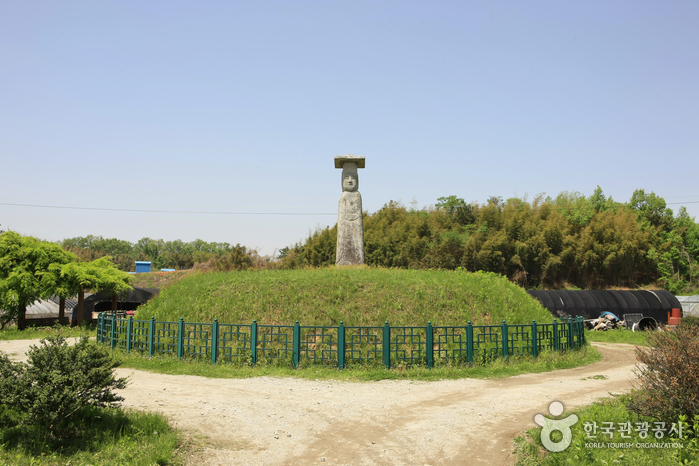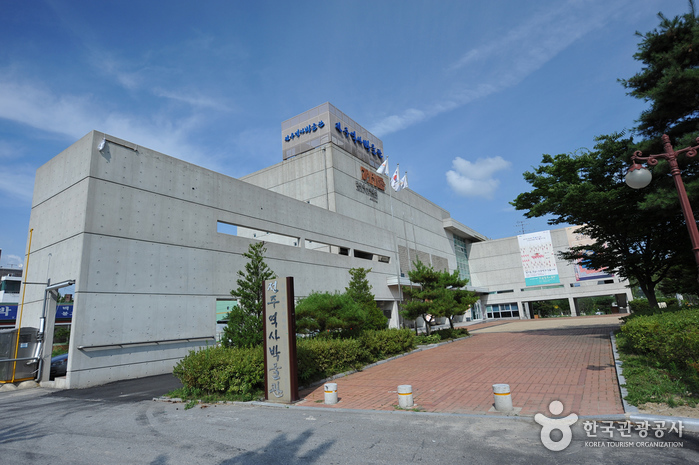Sukjonggwan of the Royal Room [Korea Quality] / 왕의지밀 숙종관 [한국관광 품질인증/Korea Quality]
11.9Km 2024-04-07
5218-14, Chunhyang-ro, Wansan-gu, Jeonju-si, Région Jeonbuk
+82-63-284-1004
This hanok (traditional Korean house) hotel combines the unique aesthetics of hanok and modern comfort. Its location near Jeonju Hanok Village, the central point of Jeonju tourism, gives it excellent access to destinations in Jeonju. As evident from its name, the hotel promises a comfortable stay in a hanok since its opening in 2018. The hotel complex stands on a plot of land spanning 19,840 m2, containing 11 residential buildings that are named after the Joseon kings and other facilities.
The building Sukjonggwan contains four rooms. Each room is a self-contained unit made up of bedrooms and restrooms, furnished with a combination of hanok’s unique charms and modern comfort. Grade 1 Gold and Silver Rooms in particular have two beds and a whirlpool bathtub for the comfort of the guests. The view of the wooden exposed beams (Gold Room) speaks to the unique characteristics of hanok, while wooden pieces of furniture give the room an elegant finish. The scenery beyond the window wall is also the pride of the hotel.
The hotel has about 150 parking spots, a hanok cafe, and the Convention Center with spaces such as Daejanggeum Hall, Saimdang Hall, Chungmugong Hall, and Hunminjeongeum Hall. Samtaegeuk and Samjogo Restaurants are designated as COVID-19 Safe Restaurants by the city of Jeonju. It takes only 10 min by car to reach most tourist sites in Jeonju Hanok Village.
King of young jo [Korea Quality] / 영조관 [한국관광 품질인증]
11.9Km 2024-04-07
5218-12, Chunhyang-ro, Wansan-gu, Jeonju-si, Région Jeonbuk
+82-63-284-1004
Yeongjogwan is one of the 11 buildings located within the Korean traditional hotel ‘Royal Room Of King’, with a view over the Jeonjucheon Stream. The hotel has 11 buildings named after the historical kings of Joseon Dynasty, and Yeongjogwan, named after the 21st king of Joseon, has two rooms: The Gold Room, and the Silver Room. Both rooms feature a design that tastefully integrates the Korean traditional hanok construction with modern techniques. The Gold Room, located on the 2nd floor of the building, is dominated by the exposed wooden beams under the roof, while the 1st floor’s Silver Room has a lower ceiling than the Gold Room, and thus feel cozier. Each unit is made up of a bedroom with two double beds, living room with low tables and seats, and a whirlpool bathroom. The bathroom is equipped with whirlpool bath and shower facilities and is separate from the toilet. The bedroom and the living room are separated by a traditional screen covered with hanji, traditional paper of Korea. Amenities in the unit include a refrigerator, electric kettle, and hairdryer.
The lawn outside is furnished with traditional plays like Yutnori, Tuho, Neolttwigi, and Gamatagi. There are two restaurants and a cafe within the hotel complex, allowing the guests to enjoy their meal in the comfort and grandeur of Korean architecture. One of the restaurants, Hyangwonjeong, offers a sumptuous breakfast spread including salads, namul (vegetable side dishes), jeon (pancakes and battered items), bread, and bacon. The hotel complex is located close to major tourist attractions of Jeonju; a 5-minute drive gets one to Jeonju Hanok Village, Nambu Market, and Pungnammun Gate.
Jeongjogwan of the Royal Room [Korea Quality] / 왕의지밀 정조관 [한국관광 품질인증/Korea Quality]
11.9Km 2024-04-08
5218-10, Chunhyang-ro, Wansan-gu, Jeonju-si, Région Jeonbuk
+82-63-284-1004
This hanok (traditional Korean house) hotel shows a different interpretation of hanok’s traditional beauty from Jeonju Hanok Village. The name of the hotel encapsulates Jeonju’s spirit as a city of tradition and art, and the exemplar of the state of Joseon. The hotel complex stands on a plot of land spanning 19,840 m2, containing 11 residential buildings and other facilities like hanok restaurants. Each residential building is named after the kings of the Joseon Dynasty. Jeongjogwan contains six rooms,
all built to modern comfort for all age groups. Grade 2 Silver and Gold Rooms, which can house up to 6 guests, are especially popular for families. The rooms combine modern comfort with hanok aesthetics, like wooden exposed beams and wooden furniture, which help to fill the room with the elegant fragrance of wood.
The hotel has about 150 parking spots, a hanok cafe, and the Convention Center with spaces such as Daejanggeum Hall, Saimdang Hall, Chungmugong Hall, and Hunminjeongeum Hall. Samtaegeuk and Samjogo Restaurants are designated as COVID-19 Safe Restaurants by the city of Jeonju. Jeonju Hanok Village is reachable by car in about 7 min.
Gojonggwan of the Royal Room [Korea Quality] / 왕의지밀 고종관 [한국관광 품질인증/Korea Quality]
11.9Km 2024-04-07
5218-8, Chunhyang-ro, Wansan-gu, Jeonju-si, Région Jeonbuk
+82-63-284-1004
This hanok (traditional Korean house) hotel was opened in 2018. Its location near Jeonju Hanok Village, the central point of Jeonju tourism, gives it excellent access to destinations in Jeonju. As evident from its name, the hotel promises a comfortable stay in a hanok. The hotel complex stands on a plot of land spanning 19,840 m2, containing 11 residential buildings and other facilities.
Each residential building is named after the kings of the Joseon Dynasty. Gojonggwan, named after King Gojong, contains six rooms. The rooms are divided into Gold and Silver Rooms, and are classified into Grade 2, Grade 3, and Grade 5 rooms, all including bathrooms and restrooms in addition to bedrooms. The rooms are furnished to offer the unique aesthetics of hanok in modern comforts. The view of the wooden exposed beams (Gold Room), wooden furniture, and the sunlight from the window wall offer an insight into the beauty of Korea’s traditional residence. All rooms are also equipped with modern comforts such as wireless Internet, TV, refrigerator, and air conditioning.
The hotel also boasts a wide array of facilities, including a spacious parking lot with a capacity of about 150 cars, a hanok cafe serving coffee and traditional tea, and the Convention Center with spaces, such as Daejanggeum Hall and Chungmugong Hall, which offers ideal venues for seminars and other large events. The two hanok restaurants on the premise, Samtaegeuk and Samjogo Restaurant, are designated as COVID-19 Safe Restaurants by the city of Jeonju. It takes only 10 min by car to reach most tourist sites in Jeonju Hanok Village.
Pagode de pierre à 5 étages de Wanggung (익산 왕궁리 오층석탑)
11.9Km 2024-04-07
San 80-1, Wanggung-ri, Wanggung-myeon, Iksan-si, Région Jeonbuk
+82-63-859-5792
La pagode de pierre à 5 étages de Wanggung est située sur une colline à environ 2km au sud de Wanggung-myeon dans la ville d’Iksan, une région réputée pour avoir été la capitale durant l’ère Mahan. La pagode se dresse sur 8,5m et fut officiellement désignée comme trésor national n°289. Les reliques de la dynastie Goryeo trouvées à l’intérieur de la pagode furent désignées trésor national n°123 et sont actuellement en exposition au Musée National de Corée. Parmi les reliques découvertes lors de la fouille archéologique, la plus célèbre, Sarijangeomgu, est un magnifique conteneur de ‘sarira’ de Buddha. La bouteille verte contenant les ‘sarira’ est dotée d’un bouchon en forme de lotus. Il y a également Sungeumgeumganggyeongpan, contenant 19 plateaux du Sutra de diamand.
Sunjonggwan of the Royal Room [Korea Quality] / 왕의지밀 순종관 [한국관광 품질인증/Korea Quality]
11.9Km 2024-04-07
5218-6, Chunhyang-ro, Wansan-gu, Jeonju-si, Région Jeonbuk
+82-63-284-1004
This hanok (traditional Korean house) hotel is located near Jeonju Hanok Village. The hotel complex stands on a plot of land spanning 19,840 m2, containing 11 residential buildings and other facilities. Modern hanok buildings are built on a line, blending with the surrounding nature to offer a comfortable stay. The name of the hotel is evident in the 11 residential buildings, all named after the kings of the Joseon Dynasty.
Sunjonggwan has six rooms in total. The rooms are divided into Gold and Silver Rooms, and are classified into Grade 2, Grade 3, and Grade 5 rooms, after the grading system used for government officials during the Joseon Period. Gold Rooms are located on the second floor, while the 1st floor is occupied by the Silver Rooms. Each room is furnished with a combination of hanok’s unique charms and modern comfort. Exposed wooden beams fill the room with a gentle scent of wood, while window walls offer an expansive view of the scenery outside.
Restaurants such as Samtaegeuk Restaurant, the site of the hotel’s breakfast offering, and Samjogo Restaurant, a Korean restaurant serving lunch and dinnertime, are designated as COVID-19 Safe Restaurants by the city of Jeonju. The Convention Center, which houses a hanok cafe, also offers a number of different facilities for the guests. It takes only 10 min by car to reach most tourist sites in Jeonju.
Rizerie Saekjang (색장정미소)
12.3Km 2024-04-08
2-15, Wonsaekjang-gil, Wansan-gu, Jeonju-si, Région Jeonbuk
La rizerie Saekjang se situe à environ 5 minutes du village des hanok de Jeonju. L'endroit est désormais un café construit sur les bases d'une rizerie datant des années 1950. Le café sert aussi de lieu d'expositions notamment autour de la photographie.
Statue de Bouddha debout de Godori à Iksan (익산 고도리 석조여래입상)
12.5Km 2024-04-07
400-2, Donggodo-ri, Geumma-myeon, Iksan-si, Région Jeonbuk
+82-63-859-5792
La statue de Bouddha debout de Godori à Iksan est le trésor n°46 de Corée. Les deux statues de Bouddha (mesurant toutes deux 424cm) se font face à une distance de 200m l’une de l’autre et montrent l’histoire d’un amour éternel mais unilatéral. Selon la légende, les deux bouddhas (un mâle, une femelle) sont amoureux mais ne peuvent se rencontrer qu’une seule nuit par an, lors du 12ème mois du calendrier lunaire. Après le coucher du soleil en ce jour spécial, la rencontre des amoureux est permise mais ces derniers doivent retourner à leur position initiale avant le chant du coq au petit matin.
Les deux statues sont très représentatives de l’ère Goryeo, qui a produit en son temps de nombreuses statues contenant très peu d’expressions corporelles. Parfaitement fidèle au style de l’époque, chaque Bouddha, qui n’a presque aucune forme, est représenté avec des habits simples et des bras à peine visibles. Sur leur tête, les bouddhas portent une couronne aggrémentée d’un deuxième chapeau de forme carrée. Avec leur visage carré, leur petits yeux, leur nez plat et petites lèvres, les bouddhas sont évocateurs des gardiens de dieu placés aux entrées des villages.
Musée de l’histoire de vie de Jeonju (전주역사박물관)
13.1Km 2024-04-07
259, Ssukgogae-ro, Wansan-gu, Jeonju-si, Région Jeonbuk
+82-63-228-6485
Le Musée de Jeonju a ouvert ses portes en 2002, montrant au public la longue et fascinante Histoire de la Corée. Il est divisé en deux expositions permanentes. La première concerne la Révolution des Fermiers Donghak (Insurrection de 1894 contre le colonialisme japonais). Evènement ayant joué un rôle important quant au dévelopement de la ville de Jeonju. La deuxième exposition est dédicacée à la mémoire des résistants, qui ont rapidement gagné la confiance des civils afin de lutter contre l’invasion japonaise. Il y a aussi un espace réservé à la mémoire du mouvement d’indépendance lorsque la Corée recouvra sa liberté face au Japon. D’autres espaces sont dédiés aux soulèvements ou évènements les plus importants de l’Histoire de la Corée.
Musée national de Jeonju (국립전주박물관)
13.2Km 2024-04-07
249, Ssukgogae-ro, Wansan-gu, Jeonju-si, Région Jeonbuk
+82-63-223-5651
Le musée national de Jeonju est un centre de recherche, de conservation et d’exposition au service des trésors du Jeollabuk-do.
Il conserve 24.000 objets anciens pour la plupart venant des royaumes de Seonsa, Mahan, et Baekje.
Il y a aussi de nombreux objets bouddhiques artisanaux, des poteries, des objets anciens en or et des ustensiles artisanaux.
Parmi cela, 1,100 pièces peuvent-être vu au musée Sangseol.
Lorsque vous entrez au rez –de - chaussée, vous pouvez voir la salle des antiquités composée en 4 parties dont la partie Seonsa.
Au 1er étage la salle des Arts et celle du folklore. Dans la salle des arts sont exposés des oeuvres de la région du Jeollabuk-do.
La salle est divisée entre des sculptures bouddhiques, des oeuvres en métal, des poteries Goryeo, des documents historiques et une galerie de peintures.
La salle du folklore est juste en face de la salle des arts et nous fait décourvrir l’unique style de vie de la région du Jeollabuk-do.
Elle est composée de la section agriculture, habitudes alimentaires, et art folklorique.
Différemment des autres pièces d’exposition, elle rassemble divers matériels de manière à avoir une vue d’ensemble compréhensible de la vie populaire de la région.
Près du musée national de Jeonju se trouve l’université de Jeonju.
Si vous avez un peu de temps, allez donc visiter le campus qui est fort propre et calme; allez à la rencontre des étudiants afin de discuter de leur culture avec eux.
![Sukjonggwan of the Royal Room [Korea Quality] / 왕의지밀 숙종관 [한국관광 품질인증/Korea Quality]](http://tong.visitkorea.or.kr/cms/resource/62/2706062_image2_1.jpg)
![King of young jo [Korea Quality] / 영조관 [한국관광 품질인증]](http://tong.visitkorea.or.kr/cms/resource/90/2637390_image2_1.jpg)
![Jeongjogwan of the Royal Room [Korea Quality] / 왕의지밀 정조관 [한국관광 품질인증/Korea Quality]](http://tong.visitkorea.or.kr/cms/resource/44/2705944_image2_1.jpg)
![Gojonggwan of the Royal Room [Korea Quality] / 왕의지밀 고종관 [한국관광 품질인증/Korea Quality]](http://tong.visitkorea.or.kr/cms/resource/37/2705937_image2_1.jpg)

![Sunjonggwan of the Royal Room [Korea Quality] / 왕의지밀 순종관 [한국관광 품질인증/Korea Quality]](http://tong.visitkorea.or.kr/cms/resource/59/2706059_image2_1.jpg)



 Français
Français
 한국어
한국어 English
English 日本語
日本語 中文(简体)
中文(简体) Deutsch
Deutsch Español
Español Русский
Русский